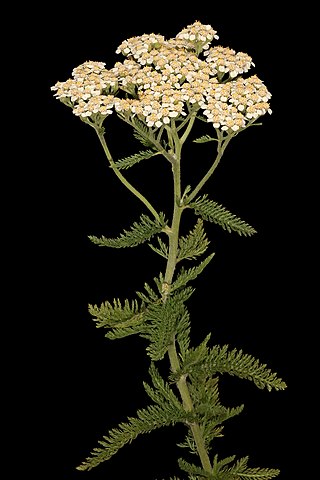
Achillea millefolium, commonly known as yarrow or common yarrow, is a flowering plant in the family Asteraceae. Other common names include old man's pepper, devil's nettle, sanguinary, milfoil, soldier's woundwort, and thousand seal.
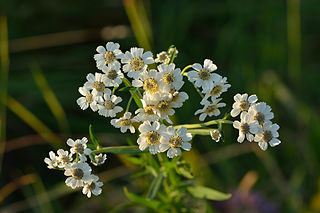
Achillea ptarmica is a European species of herbaceous perennial flowering plant in the genus Achillea of the daisy family Asteraceae. Common names include the sneezewort, sneezeweed, bastard pellitory, European pellitory, fair-maid-of-France, goose tongue, sneezewort yarrow, wild pellitory, and white tansy. It is widespread across most of Europe and naturalized in scattered places in North America. It is native to Europe and western Asia.

In molecular biology, G-quadruplex secondary structures (G4) are formed in nucleic acids by sequences that are rich in guanine. They are helical in shape and contain guanine tetrads that can form from one, two or four strands. The unimolecular forms often occur naturally near the ends of the chromosomes, better known as the telomeric regions, and in transcriptional regulatory regions of multiple genes, both in microbes and across vertebrates including oncogenes in humans. Four guanine bases can associate through Hoogsteen hydrogen bonding to form a square planar structure called a guanine tetrad, and two or more guanine tetrads can stack on top of each other to form a G-quadruplex.

Santolina is a genus of plants in the chamomile tribe within the sunflower family, primarily from the western Mediterranean region.

Coleophora trochilella is a moth of the family Coleophoridae. It is found in all of Europe, with possible exception of parts of the Balkan Peninsula.
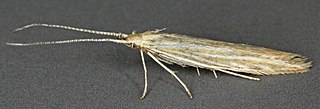
Coleophora follicularis is a moth of the family Coleophoridae. The species was first described in 1802 by Jean Nicolas Vallot, a French entomologist. It is found in all of Europe.
Coleophora vibicigerella is a moth of the family Coleophoridae found in Asia, Europe and north Africa. It was first described by Philipp Christoph Zeller in 1839.
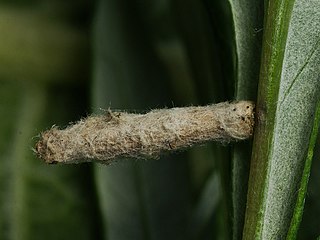
Coleophora succursella is a moth of the family Coleophoridae. It is found from Fennoscandia to the Pyrenees and Italy and from France to Poland and Slovakia.
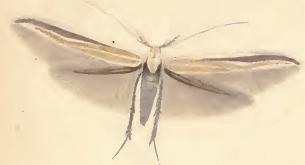
Coleophora ditella is a moth of the family Coleophoridae. It is found from Germany to the Iberian Peninsula, Italy and Bulgaria.

Coleophora gardesanella is a moth of the family Coleophoridae. It has a disjunct distribution, from Finland to the Pyrenees and Italy, and from Great Britain to the Baltic States and North Macedonia.
Coleophora lenae is a moth of the family Coleophoridae. It is found in North Macedonia.
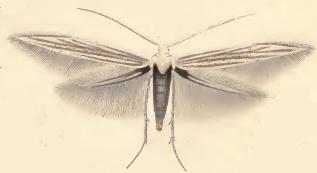
Coleophora millefolii is a moth of the family Coleophoridae. It is found in most of Europe, except Great Britain, Ireland and the Iberian Peninsula.
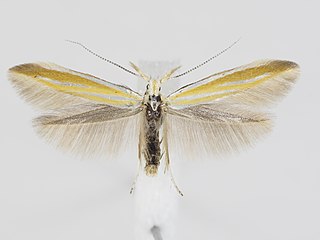
Coleophora partitella is a moth of the family Coleophoridae. It is found from Fennoscandia and to the Iberian Peninsula, Italy and Romania and from France to Poland.
Coleophora ptarmicia is a moth of the family Coleophoridae. It is found in Austria, Croatia, Slovakia, the Czech Republic, France, Hungary, Italy, Latvia, Lithuania, southern Russia, and the eastern Palearctic realm. It is also found in China.

Coleophora argentula is a moth of the family Coleophoridae, found in most of Europe, Russia and Asia Minor. The larvae live in cases and feed on the seeds of yarrow and sneezewort.
Coleophora carelica is a moth of the family Coleophoridae. It is found in Latvia, Estonia, Finland, and northern Russia.
Coleophora coarctataephaga is a moth of the family Coleophoridae. It is found in Romania, Bulgaria, North Macedonia, Albania and Greece.
Coleophora quadristraminella is a moth of the family Coleophoridae. It is found in France, Italy, Croatia, North Macedonia and Greece.
Coleophora pseudorepentis is a moth of the family Coleophoridae. It is found in France, Germany, Austria, Italy, Croatia, Hungary, Slovakia, Ukraine, Sardinia and Corsica.

Achillea alpina, commonly known as alpine yarrow, Chinese yarrow or Siberian yarrow, is an Asian and North American species of plant in the sunflower family. It is native to Siberia, the Russian Far East, China, Mongolia, Korea, Japan, Nepal, Canada, the northern United States.











